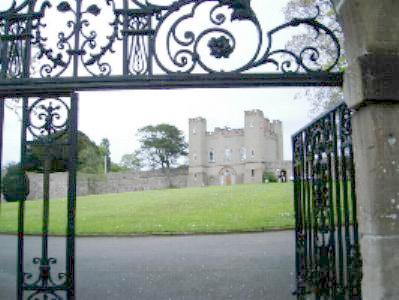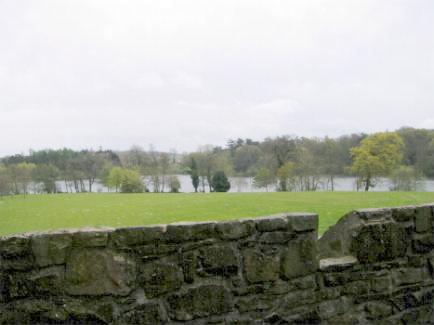|
|
Hillsborough Town. (Cromghlinn) |
| |
Named
for plantation family Hill. |
||||||||||||||
|
Colonel Arthur The Hills built Hillsborough fort in 1650, the site was chosen because it commanded the road from Dublin to Carrickfergus 'a route which may be taken by warring Irish rebels' it was said at the time. The fort was built on the site of a earlier Magennis fort which in turn was probably built on a rath or dun dating from early times. From the ramparts of the fort are views over an ornamental lake. Construction of the fort began in 1630 by Hugh
Hill's The fort was remodeled in the 18th century losing its austere military aspect and ornamented with gothic arches in line with taste at the time. A gazebo was also built at this time in memory of Bishop Taylor who lived with the Hills in the 1660's. There are views from the southeast rampart over a beautiful artificial lake and from the north rampart to an elegant parish church, which was built in 1636 and gothisied in the 1760's. It has stained glass by Joshua Reynolds (16 July 1723 – 23 February 1792) and a memorial by sculptor Joseph Nollekens (1737-1823), the church has two magnificent 18th century organs. Hamilton Harty (1879-1941), the brilliant interpreter of romantic music known by some as 'The Irish Toscanini' He was born in Hillsborough and his father was church organist here for 40 years, he is buried in the graveyard. It is said that William III spent a night here on his way to the battle of the Boyne in 1690. In the 1800's the Hill family used the first floor of the gate house for social occasions, such as marriages. It is said that in 1837 the whole enclosure of the fort was laid out and 3,500 guests dined on roast beef and plum pudding. The 1798 Rebellion. See also The 1798 Rebellion | Irish History and The United Irishmen. The main body The square at the top of the hill is surrounded by fine Georgian houses and the massive wrought iron gates of Hillsborough castle, formally the residence of the Governor of Northern Ireland. The gates which were made in 1745 by the Thornberry brothers, they originally stood at the entrance to Richill Castle, and were brought to Hillsborough in 1936. They are an exceptionally fine example of the Blacksmith's craft. There are many other examples of early ornamental ironwork to be seen in Hillsborough. Hillsborough castle is open to the public on Saturday's only from 10.30 am until 4.00 pm during May and June
In the summer the town competes in the Ulster in bloom competition, during this period the town is festooned with tastefully arranged colorful hanging baskets and window boxes. A delight to behold and a credit to the hardworking people involved. More images of Hillsborough.
|
||||||||||||||
|
|
| |
 Hill
he was an officer in the army of the Earl of Essex sent by Elizabeth I
to subdue the rebellious O'Neill. He was granted a tract of confiscated
land, stayed on and married the sister of Sorley Boy MacDonnell,
Hill
he was an officer in the army of the Earl of Essex sent by Elizabeth I
to subdue the rebellious O'Neill. He was granted a tract of confiscated
land, stayed on and married the sister of Sorley Boy MacDonnell,  older
brother Peter, it is square with sides 270 ft long enclosed by a stone
faced earthen rampart wide enough to accommodate heavy cannons, at each
corner there are spear shaped bastions
older
brother Peter, it is square with sides 270 ft long enclosed by a stone
faced earthen rampart wide enough to accommodate heavy cannons, at each
corner there are spear shaped bastions of
the town stands on a steep hill at the bottom
of which is an elegant Gothic revival church St Malachy's. Going up the
hill the main street which is lined by substantial black stone houses
and shops many of which sell antiques and crafts.
of
the town stands on a steep hill at the bottom
of which is an elegant Gothic revival church St Malachy's. Going up the
hill the main street which is lined by substantial black stone houses
and shops many of which sell antiques and crafts.